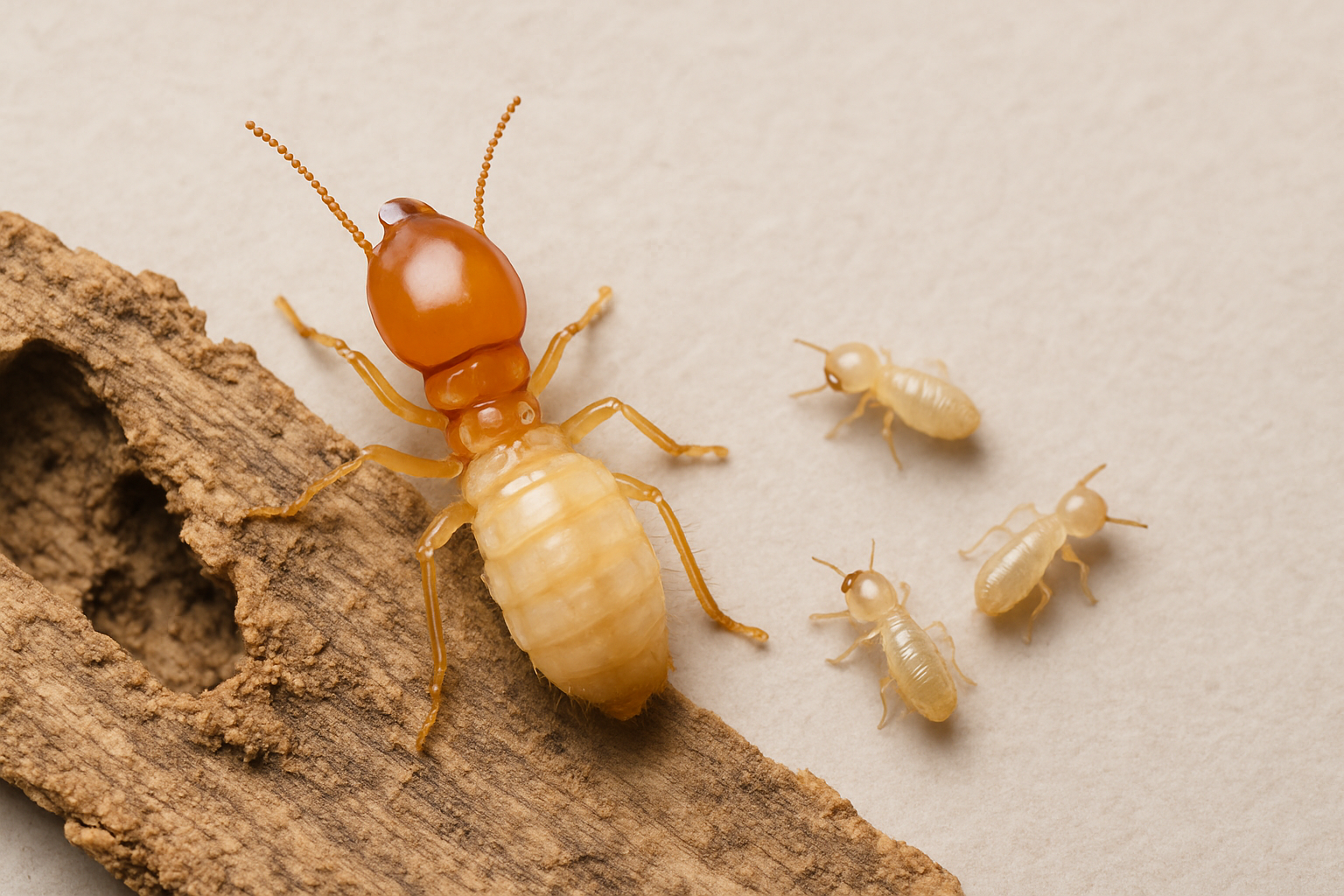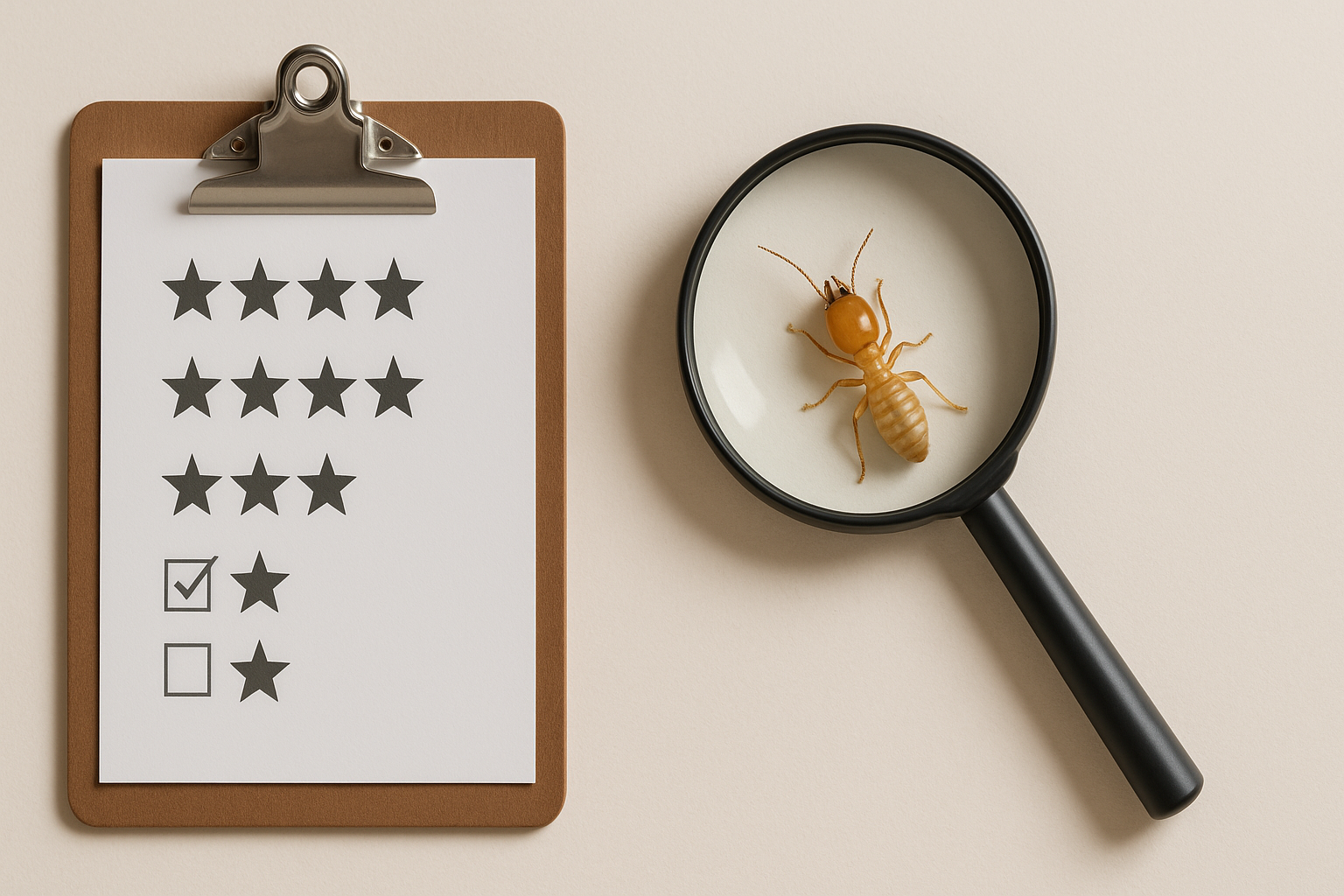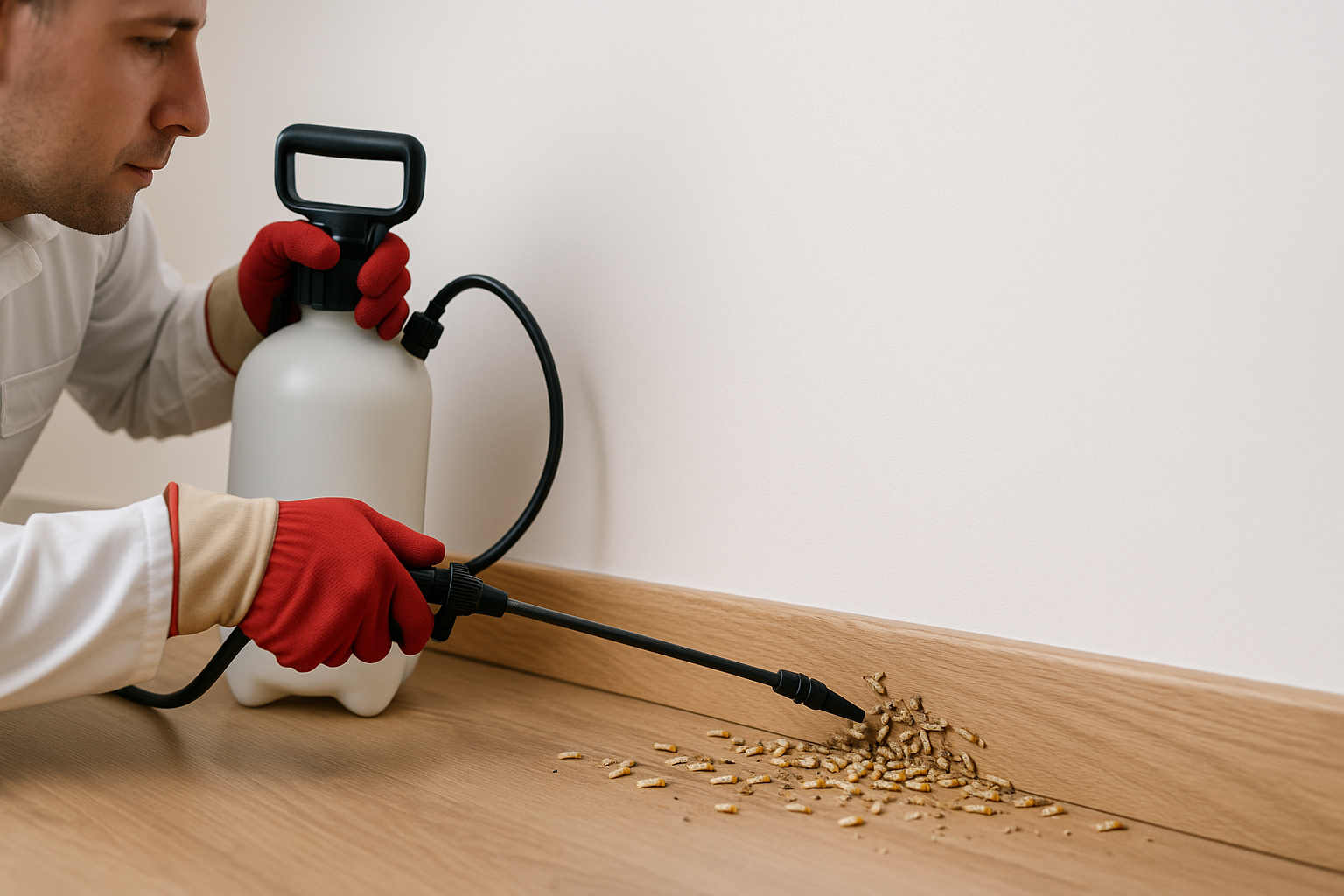Table of Contents
Overview of Termite Biology Oud Al Muteena 2
The subject of termite biology Oud Al Muteena 2 is essential for anyone residing in Dubai, especially those concerned about the integrity of their properties. This understanding helps homeowners, facility managers, and pest control experts combat infestations effectively. This species exhibits complex social structures and behavior that directly impact their detection and eradication.
Termites in Oud Al Muteena 2 belong to subterranean species common to Dubai’s humid climate and urban structures. Their biology revolves around colony dynamics with distinct castes including workers, soldiers, and reproductive individuals. Knowledge of these roles is critical when inspecting or treating affected areas to ensure comprehensive control.
Termite biology Oud Al Muteena 2 shows that these insects feed primarily on cellulose material found in wooden structures, paper products, and even some plastics found in constructions. This consumption pattern often leads to significant damage before the infestation becomes visible, emphasizing early detection and targeted treatment practices.
The environmental conditions of Oud Al Muteena 2, with Dubai’s localized humidity and building materials, influence termite activity and colony health. Understanding these localized biological traits allows for customized management strategies that are both efficient and sustainable.
Inspection Process for Termite Biology Oud Al Muteena 2
When dealing with termite biology Oud Al Muteena 2, the inspection process in Dubai follows a precise protocol to identify infestation levels, routes of entry, and colony size. Professionals trained in this field conduct thorough examinations of both the interior and exterior of properties.
The process starts with visual indicators such as mud tubes, damaged wood, and discarded wings, which often serve as the initial clues to termite biology Oud Al Muteena 2 presence. Inspectors will also assess moisture levels in structural components since termites thrive in damp conditions common in Oud Al Muteena 2.
Advanced tools like moisture meters and infrared cameras support the physical inspection, enabling technicians to detect termite activity hidden inside walls or under flooring. This high-tech approach improves accuracy while reducing the invasiveness of the inspection.
To outline the inspection steps more succinctly for termite biology Oud Al Muteena 2, here is a list of key tasks:
- Survey of accessible wooden structures and furnishings
- Detection of termite-specific signs like mud tubes or galleries
- Moisture level measurement in suspect areas
- Use of non-destructive technologies (infrared and acoustic tools)
- Documentation and reporting of findings with risk assessment
The Dubai Municipality mandates regular building inspections to identify pest issues early. For termite biology Oud Al Muteena 2, these inspections help protect both residential and commercial properties, aligning with local public health standards.
Key Questions FAQ on Termite Biology Oud Al Muteena 2
Understanding termite biology Oud Al Muteena 2 extends beyond the biology itself and includes common concerns related to detection, prevention, and treatment. Below are frequently asked questions related to termite biology Oud Al Muteena 2 that Dubai residents commonly ask.
What signs indicate termites in Oud Al Muteena 2?
The classic signs include hollow-sounding wood, mud tubes along walls, and small holes or blistered surfaces on wooden items. Additionally, discarded termite wings near windowsills or doors in Oud Al Muteena 2 often signal reproductive swarms, a sign of colony maturity and spread.
How often should I schedule a termite inspection in Oud Al Muteena 2?
Experts recommend at least one comprehensive termite biology Oud Al Muteena 2 inspection annually. If your property is near green areas or older structures, bi-annual checks can provide more security against infestation and costly damage.
Can termite infestations be fully eradicated in Oud Al Muteena 2?
With professional intervention tailored to termite biology Oud Al Muteena 2, complete eradication is achievable. Treatment may involve bait systems, liquid termiticides, or physical barriers. A follow-up inspection ensures that all colonies have been eliminated and helps plan ongoing prevention.
Are there environmentally friendly options for Termite Control in Oud Al Muteena 2?
Yes, Dubai’s pest control providers are increasingly using eco-friendly solutions, including biological control agents and reduced-risk chemicals, aligning with Dubai Municipality’s environmental regulations. These options consider termite biology Oud Al Muteena 2 to maximize safety for residents and pets.
Where can I find official guidelines on Termite Pest Control in Dubai?
The Dubai Municipality Public Health Pest Control Section provides comprehensive standards and advice for managing termite biology Oud Al Muteena 2. Their guidelines are essential for all licensed pest control operators and residents.
Service Professionals for Termite Biology Oud Al Muteena 2 in Dubai
In Dubai, termite biology Oud Al Muteena 2 services are offered by specialized pest control companies focusing on sustainable and effective termite management. Saniex is a leading provider, uniquely operating within Dubai with deep knowledge of termite biology Oud Al Muteena 2 and tailored treatment plans.
Choosing an expert who understands local termite behavior enables faster response times and more accurate diagnosis. Saniex technicians are trained on both modern technologies and traditional inspection methods, providing a robust mixed approach.
For more details on their service portfolio related to pest control, you can visit the Saniex General Pest Control page for insights into termite biology Oud Al Muteena 2. Their service offerings include inspections, treatment, prevention, and maintenance customized for Dubai’s unique pest ecosystem.
Here are practical tips when hiring termite biology Oud Al Muteena 2 professionals in Dubai:
- Verify licensing and certifications specific to Dubai Municipality standards
- Ask about treatment methods aligned with local termite species and behaviors
- Ensure follow-up and guarantee policies are included
- Check for eco-friendly and safety practices emphasized
- Read customer reviews focused on Dubai area experiences
Conclusion and Call to Action
Understanding this local pest is vital for maintaining secure and healthy living environments in Dubai. This article has covered critical insights into the biology, inspection process, FAQs, and trusted service providers dedicated to this unique pest challenge. Acting early and choosing knowledgeable professionals like Saniex can safeguard your property against costly damage caused by termites.
If you notice any signs of termite activity or simply want to secure your home with a professional inspection, don’t hesitate to engage licensed experts. Protect your investment and well-being by leveraging Dubai-specific knowledge and best practices tailored for effective pest management.
Start today by scheduling a thorough termite inspection to keep your Dubai residence termite-free and structurally sound.
Understanding Termite Biology Oud Al Muteena 2: Insights into Local Species and Behavior
Termite infestations remain a significant concern in residential and commercial properties across Dubai, particularly in older neighborhoods such as Oud Al Muteena 2. A comprehensive understanding of these pests is essential for effective prevention and control. This section delves into the biological characteristics of termites commonly found in this area, their colony structure, and how their behavior adapts to the unique climatic and structural conditions found in Dubai’s urban environment.
Termite Species and Adaptation in Oud Al Muteena 2
While termites are a global pest, the species prevalent in Oud Al Muteena 2 have specific adaptations to thrive in the hot desert climate of Dubai. The most common species found in this area belong to the subfamily Kalotermitidae (drywood termites) and Rhinotermitidae (subterranean termites). Drywood termites are particularly adept at infesting wooden structures without the need for soil contact, which makes them a frequent pest in buildings constructed primarily of wood or wood-based materials. Subterranean termites, on the other hand, require moist soil to survive and build mud tubes to access above-ground food sources like wooden beams or furniture.
In Oud Al Muteena 2, the arid environment influences termite biology in unique ways. These termites tend to modify their foraging and breeding behaviors to cope with scarcity of moisture. For example, subterranean termites often establish their colonies near irrigated gardens, plumbing leaks, or damp foundations, places where moisture is retained. This behavior is particularly relevant for homeowners and businesses in Oud Al Muteena 2, where landscaping practices and aging water infrastructure can inadvertently support termite survival.
Colony Structure and Life Cycle: Why Understanding It Matters
Termite colonies are complex, highly organized social structures, and their life cycle stages are critical in the context of effective pest management. In this local context, understanding colony hierarchy and development stages can help residents and pest control professionals identify active infestations and vulnerable points in the termite life cycle.
A typical termite colony includes the following roles:
- Reproductives: These include the king and queen, responsible for reproduction and colony expansion through egg laying.
- Workers: Sterile, blind termites that maintain the nest, procure food, and care for the young.
- Soldiers: Defend the colony against predators such as ants and other termite colonies.
- Alates (swarmers): Winged reproductives that leave the colony to mate and establish new colonies.
The life cycle begins when alates swarm during specific seasons, often triggered by environmental factors like humidity following rare rainfall events. In Dubai’s dry climate, these swarming events are less frequent but still crucial for the propagation of termite populations in Oud Al Muteena 2. After mating, alates shed their wings and start new colonies, usually within wooden parts of buildings or subterranean nests.
Knowledge of this cycle is essential for timing pest control interventions. For example, treatments targeting alates during swarm seasons can effectively reduce termite spread, while continuous monitoring of worker activities in structures can prevent established colonies from causing significant damage.
Environmental Factors Influencing Termite Biology in Oud Al Muteena 2
The biology of termites in this Dubai locality is heavily shaped by environmental factors that are specific to the region:
- Climate: High temperatures and low humidity impact termite survival, directing colonies to seek moisture-rich micro-environments within buildings.
- Urban infrastructure: Aging plumbing, garden irrigation systems, and building materials commonly found in Oud Al Muteena 2 provide entry points and habitats.
- Vegetation: The type and density of trees and shrubs influence subterranean termite foraging since roots and decaying wood are natural food sources.
Specifically, the presence of date palms and other common Middle Eastern vegetation in Oud Al Muteena 2 can be associated with increased termite activity, as these plants provide organic matter both above and below ground. Additionally, water leaks and poor drainage are often overlooked contributors to termite infestations, especially in the warm, dry climate where termites aggressively seek moisture.
Implications for Pest Management and Structural Integrity
Understanding these specific biological aspects is fundamental for the development of targeted and effective pest management strategies compliant with Dubai Municipality’s regulations and the UAE’s pest control standards. Early detection techniques such as moisture meters, acoustic sensors, and regular visual inspections play critical roles in identifying termite colonies before major damage occurs. Furthermore, knowledge about termite species and behaviors enables pest control operators to select appropriate treatment methods—be it chemical soil treatment around foundations, localized bait systems, or whole-structure fumigation—aligned with Dubai Health Authority (DHA) guidelines to ensure safety and environmental responsibility.
Importantly, the structural materials commonly used in Oud Al Muteena 2, including traditional wooden doors, furniture, and certain types of insulation, tend to be preferred by drywood termites. This necessitates periodic inspections and integrated pest management approaches that combine physical barriers, habitat modification, and professional treatment services to maintain building integrity and occupant health.
Moreover, residents and property managers in Oud Al Muteena 2 are encouraged to implement preventive measures such as:
- Regularly repairing plumbing leaks and improving drainage.
- Reducing wood-to-soil contact in landscaping or building foundations.
- Maintaining adequate ventilation to reduce interior humidity.
- Promptly addressing signs of termite damage such as hollow-sounding wood, discarded wings, or mud tubes.
Combining an understanding of termite biology with proactive maintenance not only helps protect properties but also aligns with Dubai’s building codes and the UAE Fire & Life Safety Code that emphasize pest management’s role in overall public safety.
In conclusion, these termites exhibit specific adaptations and behaviors shaped by Dubai’s environmental and urban context, making localized knowledge essential. Through an informed approach that leverages this biological understanding, residents and pest control professionals alike can better safeguard properties and contribute to a termite-resilient community.





